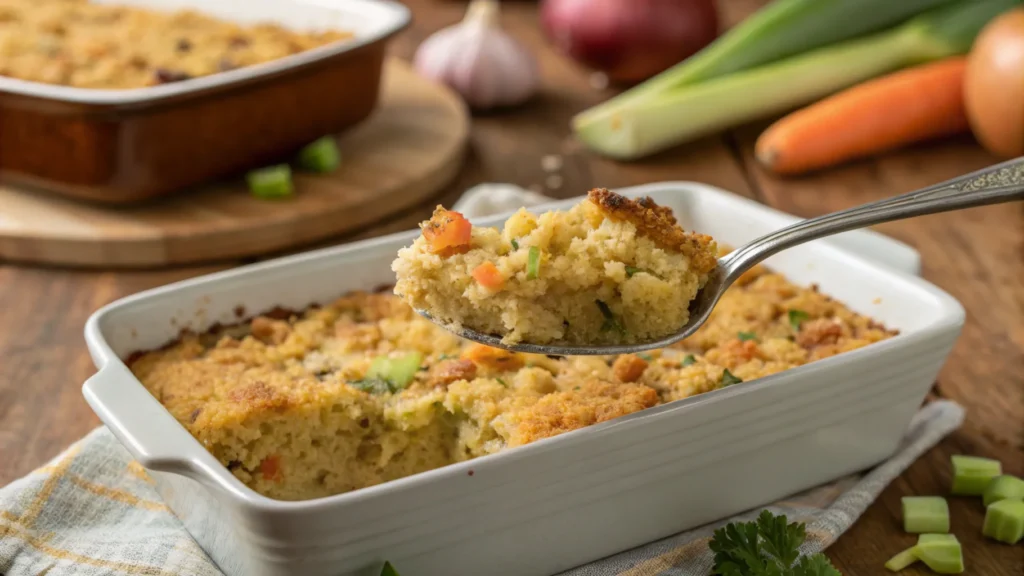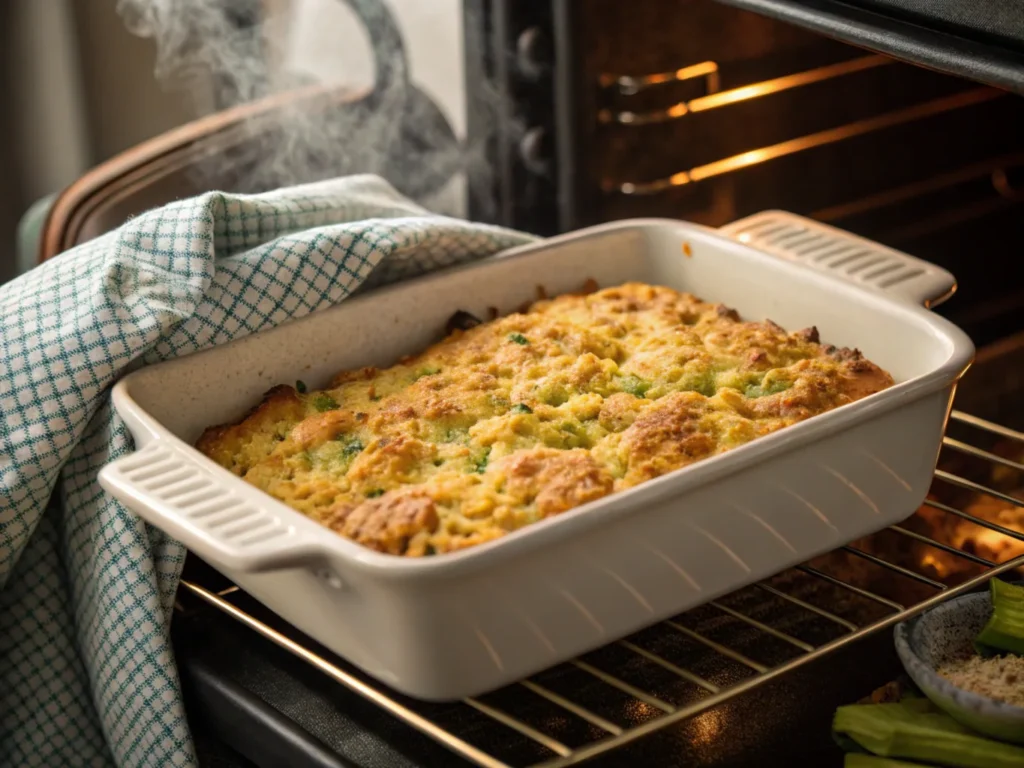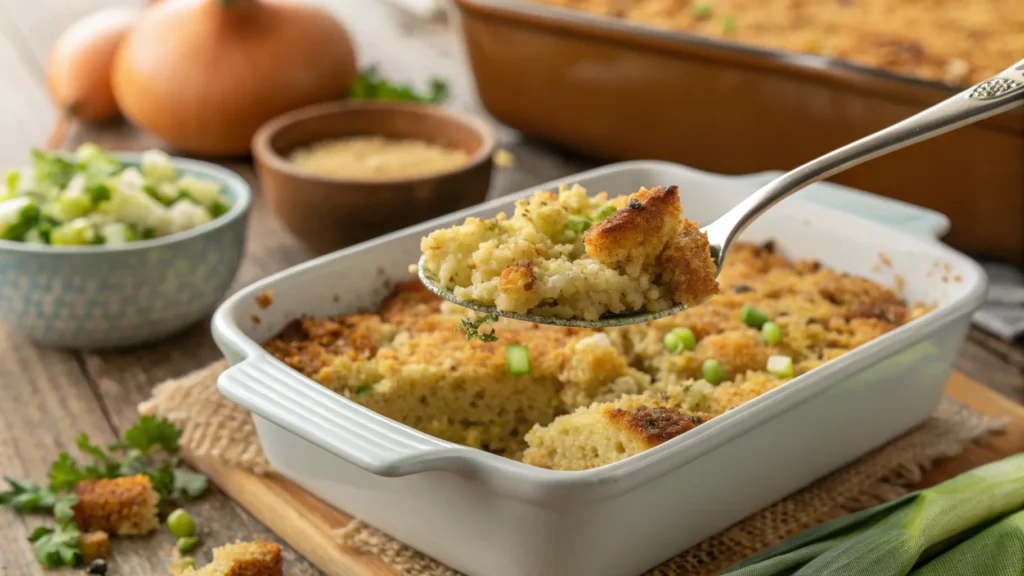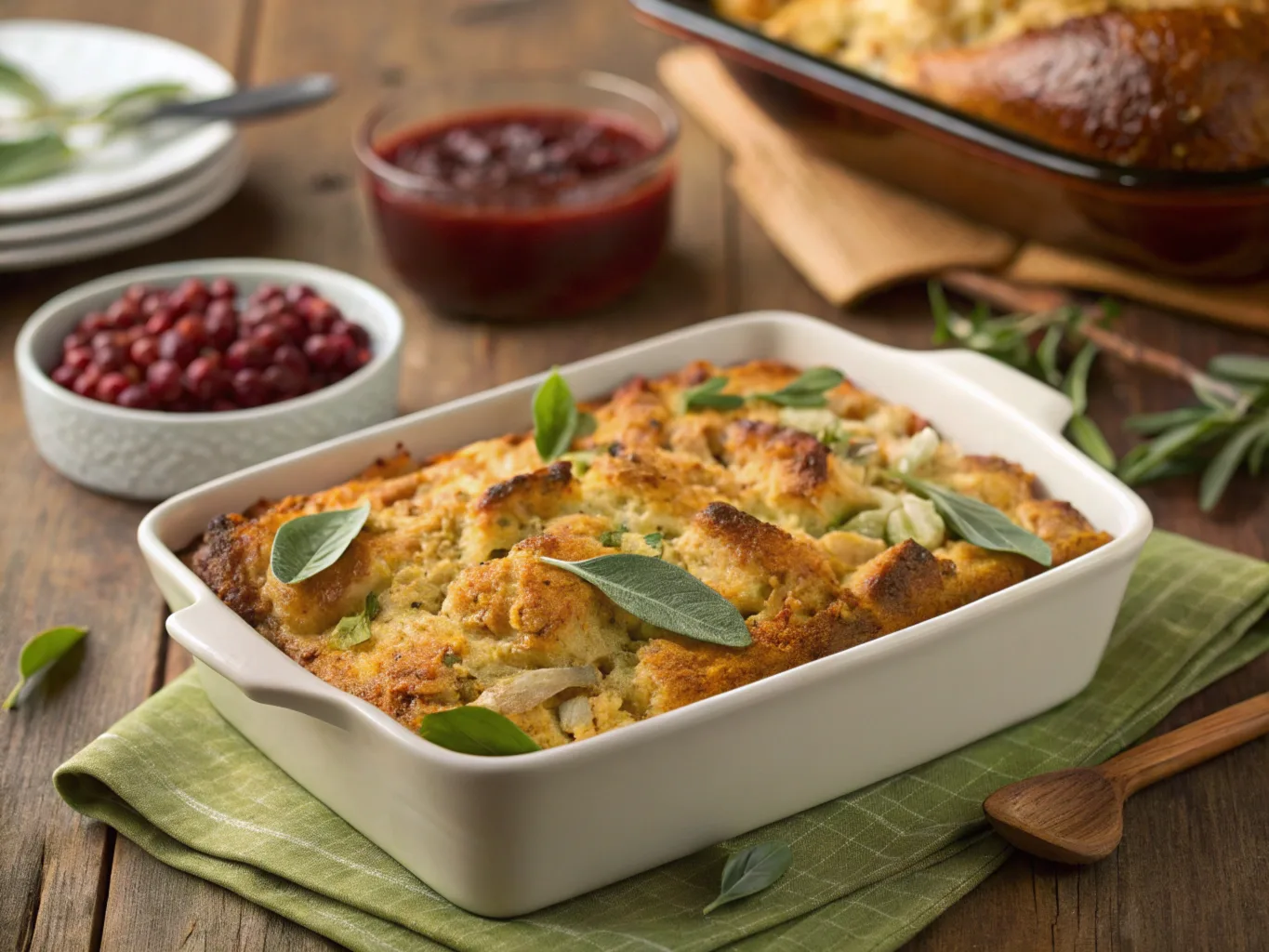Let’s face it, there’s nothing worse than dishing up your cornbread dressing only to find out it’s a soggy mess. If you’ve ever asked, “How to fix runny cornbread dressing?” you’re not alone. The good news is that this common kitchen mishap is totally fixable! Whether you’re making it for a big holiday feast or a cozy dinner at home, I’ve got practical tips to save your dressing and make it the star of the meal. Trust me, by the end of this, your cornbread dressing will be just the way you like it moist but not mushy, flavorful, and totally irresistible.

Common Causes of Runny Cornbread Dressing
Before fixing the issue, it’s good to understand what might have gone wrong. Knowing how to fix runny cornbread dressing starts with identifying the cause. Here are the most common culprits behind soggy dressing
Understanding What Makes Cornbread Dressing Too Wet
Runny cornbread dressing can happen to anyone, but it’s usually fixable. The key is knowing what caused the issue so you can adjust and get it just right.
- 1. Too Much Liquid
Adding too much broth or liquid is the top reason for soggy dressing. Knowing how to fix runny cornbread dressing in this case means adjusting your ratios next time go slow when adding broth!
- 2. Fresh Cornbread
If your cornbread is too fresh, it might not absorb liquid properly. This can leave you wondering how to fix runny cornbread dressing at the last minute. Day-old cornbread is much better at holding up to the mix.
- 3. Undercooked Dressing
Sometimes, you just haven’t baked your dressing long enough. When thinking about how to fix runny cornbread dressing, baking it uncovered for another 10-15 minutes might be all it takes to get it right.
- 4. Wrong Ingredient Ratios
Too much of certain ingredients like vegetables or eggs can upset the balance of your dressing, making it runny or overly dense.
Now that you know what might have gone wrong, let’s fix it!
How to Fix Runny Cornbread Dressing

Smart Fixes for Runny Cornbread Dressing
If your dressing turns out too wet, don’t panic. These easy, practical solutions will help rescue the texture and bring your dish back to delicious.
1. Bake It Longer
The easiest solution? Bake it for a little longer. If your dressing is fully assembled but looks too wet, put it back in the oven uncovered. The extra baking time will help evaporate the excess moisture. Start with 10-15 minutes and check it frequently to avoid drying it out completely.
2. Add More Cornbread
If the texture is too wet, crumble in some extra cornbread. This will absorb the liquid and give the dressing a firmer structure. Use cornbread that’s slightly dry for the best results.

3. Use Bread Crumbs or Crackers
No leftover cornbread? No problem! Toss in some plain breadcrumbs or crushed saltine crackers to soak up the extra moisture. Stir gently to distribute evenly before baking again.
4. Adjust the Liquid
If your dressing looks too wet while mixing, stop adding broth. Instead, balance it out by stirring in more crumbled cornbread or breadcrumbs. This is a proactive way to address how to fix runny cornbread dressing before it even becomes a problem.
5. Sauté Vegetables First
If raw vegetables release too much liquid during baking, they can make the dressing soggy. Next time, sauté your onions, celery, and any other veggies in butter before adding them to the mix. This reduces their water content and boosts flavor!
6. Let It Rest
Sometimes, runny dressing just needs a little time. Once it’s out of the oven, let it sit for about 10-15 minutes. The residual heat will help firm it up as it cools slightly.
Tips to Prevent Runny Cornbread Dressing
The best way to handle a runny dressing is to avoid it altogether. Here are some tried-and-true tips to guarantee your cornbread dressing turns out perfectly every time.
Simple Strategies to Keep Dressing from Getting Soggy
Preventing runny cornbread dressing starts with smart prep. These easy tips will help you get that golden, moist, never-mushy texture every single time.
1. Use Day-Old Cornbread
Freshly baked cornbread might seem tempting, but it’s too soft and moist for dressing. Use cornbread that’s at least a day old, or bake it fresh and let it sit out overnight to dry. Dry cornbread absorbs liquid better and holds its structure during baking.
2. Add Liquid Gradually
When adding broth, go slow. Start with a small amount, stir it in, and check the consistency. You’re aiming for a moist, cohesive mix not a soup. You can always add more broth later if needed.
3. Sauté Your Veggies
Raw vegetables release moisture as they cook, which can water down your dressing. Sauté onions, celery, and any other veggies in butter or oil until they’re soft and fragrant. This not only reduces excess water but also boosts flavor.
4. Pre-Taste Your Mixture
Before baking, taste your dressing mixture. If it feels too wet, add more crumbled cornbread or breadcrumbs to soak up the excess. Adjust the seasoning while you’re at it there’s nothing worse than bland dressing!
5. Bake Uncovered
Covering your dressing while baking traps steam, which can make it soggy. Instead, bake it uncovered to allow moisture to evaporate and create a slightly crisp, golden top.
6. Use the Right Pan
Avoid deep baking dishes for cornbread dressing. A shallow, wide casserole dish works best because it allows for even baking and helps excess moisture cook off.
7. Watch Your Timing
Overcooking can dry out dressing, but undercooking leaves it runny. Bake at 375°F for 30-40 minutes, keeping an eye on the texture. The top should be golden brown, and the center should be set but still moist.
8. Don’t Overdo the Eggs
Eggs are great for binding the mixture, but too many can make the dressing dense and wet. Stick to 1-2 eggs for most recipes, unless you’re making a very large batch.
Serving Ideas for Cornbread Dressing
Now that you’ve mastered fixing and preventing runny cornbread dressing, let’s talk about serving it up in style. This dish is a classic comfort food that pairs beautifully with all kinds of meals, from big holiday feasts to cozy family dinners.
Delicious Ways to Serve Cornbread Dressing
From festive mains to comforting sides and clever leftover ideas, these serving suggestions make your cornbread dressing the most versatile dish on the table:
1. Classic Holiday Pairings
Cornbread dressing is a must-have for Thanksgiving and Christmas dinners. Serve it alongside:
- Roast Turkey: The ultimate match! Add some gravy on top for the perfect bite.
- Honey-Glazed Ham: The sweet and savory combo is a holiday favorite.
- Cranberry Sauce: The tartness cuts through the richness of the dressing beautifully.
2. Southern Comfort Combos
For a true taste of the South, pair cornbread dressing with:
- Fried Chicken: Crispy chicken and moist dressing? Yes, please!
- Collard Greens: Add a little vinegar for a tangy contrast.
- Mac and Cheese: Creamy, cheesy goodness next to your savory dressing is a dream come true.
3. Light and Fresh Sides
If you want to keep things balanced, add a few lighter options:
- Simple Salad: A fresh green salad with vinaigrette complements the rich flavors.
- Roasted Vegetables: Think carrots, Brussels sprouts, or asparagus for a pop of color and flavor.
- Steamed Green Beans: Add a squeeze of lemon for a bright, zesty side.
4. Creative Leftover Ideas
Got extra cornbread dressing? Don’t let it go to waste! Try these ideas:
- Stuffed Bell Peppers: Fill halved bell peppers with dressing, top with cheese, and bake.
- Breakfast Casserole: Mix the dressing with scrambled eggs, sausage, and cheese for a hearty morning dish.
- Soup Topper: Crumble leftover dressing over a bowl of turkey or chicken soup for added flavor.
5. Serve It as the Star
While cornbread dressing is usually a side, it can hold its own as the main event. Pair it with a hearty gravy or serve it as part of a casserole with shredded chicken or turkey mixed in. It’s filling, comforting, and satisfying enough to take center stage.

How to Fix Runny Cornbread Dressing
Ingredients
Equipment
Method
- Preheat oven to 375°F. If dressing is too wet, place it uncovered in a shallow dish.
- Add extra crumbled cornbread or breadcrumbs to absorb excess moisture. Stir gently to combine.
- Check liquid levels; avoid adding more broth. Use reserved broth cautiously to balance moisture if needed.
- Bake uncovered for 10–15 minutes to reduce moisture. Watch closely to avoid drying it out.
- Let dressing rest for 10–15 minutes before serving. This helps it firm up with residual heat.
Nutrition
Notes
Tried this recipe?
Let us know how it was!Conclusion
When it comes to cornbread dressing, a runny texture doesn’t have to ruin your meal. With a few simple adjustments like baking it longer, adding more cornbread, or sautéing your veggies you can save the day and serve a dish that’s moist, flavorful, and perfectly balanced. Plus, with the tips to prevent sogginess next time, you’ll nail your dressing every single time.
Whether it’s for Thanksgiving, a cozy family dinner, or even as leftovers reinvented, cornbread dressing is a classic comfort food that deserves its place on your plate. So go ahead, serve it up, and watch everyone come back for seconds!
LET’S STAY CONNECTED! FOLLOW ME ON:
Tried this recipe? I’d be thrilled to see your take on it! Snap a pic and tag me @Sweftyrecipes so I can share your delicious creations with our foodie community.
→ FACEBOOK | INSTAGRAM | PINTEREST
FAQ: Common Questions About Cornbread Dressing
Is stuffing better with or without eggs?
Eggs are optional but highly recommended for stuffing or dressing. They act as a binder, giving your dressing a cohesive texture without being too dense. If you prefer a looser, crumbly consistency, you can skip the eggs, but adding 1-2 eggs will create a richer, more custard-like dish.
Do you cover your dressing when baking?
It depends on the texture you’re aiming for! Baking your dressing uncovered allows the top to become golden and slightly crispy, which many people love. If you prefer a softer texture, you can cover it with foil for the first 20-25 minutes of baking and then uncover it for the last 10-15 minutes to let the top brown.
What is the best way to dry out cornbread for stuffing?
The easiest way to dry out cornbread is to bake it ahead of time and let it sit out overnight, uncovered. If you’re short on time, crumble the cornbread onto a baking sheet and bake it at 250°F for 15-20 minutes, stirring occasionally, until it’s dry but not toasted.
Why is my cornbread dressing bland?
Bland dressing usually means it’s under-seasoned. Cornbread itself has a mild flavor, so don’t be shy with herbs like sage, thyme, and rosemary. Make sure to taste your mixture before baking and add salt, pepper, and any spices as needed. Sautéed onions, celery, and even a touch of garlic can also boost flavor.
What is the difference between cornbread dressing and stuffing?
The key difference is how they’re prepared. Dressing is baked in a separate dish, while stuffing is traditionally cooked inside a bird, like a turkey. Cornbread dressing is a Southern classic, often made with crumbled cornbread as the base, while stuffing may use bread cubes or other types of bread.

3 thoughts on “How to fix runny cornbread dressing?”
Comments are closed.